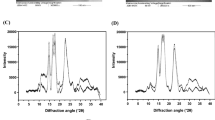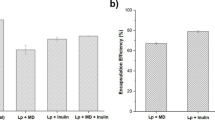Abstract
In this study, the effects of encapsulation with maltodextrin and reconstituted skim milk (RSM) and their binary and ternary blends with gum arabic (GA) by spray and freeze drying methods on viability of probiotic Lactobacillus casei Shirota under different stress conditions were evaluated. All microcapsules showed high survival ratios (7.91–9.37 log cfu/g) after microencapsulation. The viability of microencapsulated cells was significantly higher than free cells when exposed to stress conditions. Spray dried microcapsules exposed to low pH showed small decrease in the viability of cells compared to freeze dried microcapsules, but freeze drying microcapsules showed higher protective effect at 85 and 90 °C. After exposure to 3% bile salt, almost 2.5 log decreases in the encapsulated cell counts were determined for both methods. The results indicated that using RSM:GA mixture as an encapsulating agent showed the higher cell protection against high temperature, acidic pH and bile salts.





Similar content being viewed by others
References
Ainsley Reid A, Vuillemard JC, Britten M, Arcand Y, Farnworth E, Champagne C P. Microentrapment of probiotic bacteria in a Ca(2 +)-induced whey protein gel and effects on their viability in a dynamic gastro-intestinal model. J. Microencapsul. 22: 603–619 (2005)
Arslan S, Erbas M, Tontul I, Topuz A. Microencapsulation of probiotic Saccharomyces cerevisiae var. boulardii with different wall materials by spray drying. LWT–Food Sci. Technol. 63: 685–690 (2015)
Augustin M A, Hemar Y. Nano- and micro-structured assemblies for encapsulation of food ingredients. Chem. Soc. Rev. 38: 902–912 (2009)
Brinques G B, Ayub MAZ. Effect of microencapsulation on survival of Lactobacillus plantarum in simulated gastrointestinal conditions, refrigeration, and yogurt. J. Food Eng. 103: 123–128 (2011)
Cano-Higuita DM, Malacrida CR, Telis VRN. Stability of curcumin microencapsulated by spray and freeze drying in binary and ternary matrices of maltodextrin, gum Arabic and modified starch. J. Food Process. Preserv. 39: 2049–2060 (2015)
Cook MT, Tzortzis G, Charalampopoulos D, Khutoryanskiy VV. Microencapsulation of probiotics for gastrointestinal delivery. J. Control Release. 162: 56–67 (2012)
Corcoran BM, Stanton C, Fitzgerald G, Ross RP. Life under stress: the probiotic stress response and how it may be manipulated. Curr. Pharm. Des. 14: 1382–1399 (2008)
De Castro-Cislaghi FP, Silva CDRE, Fritzen-Freire CB, Lorenz JG, Sant’Anna ES. Bifidobacterium Bb-12 microencapsulated by spray drying with whey: Survival under simulated gastrointestinal conditions, tolerance to NaCl, and viability during storage. J. Food Eng. 113: 186–193 (2012)
Desmond C, Ross RP, O’Callaghan E, Fitzgerald G, Stanton C. Improved survival of Lactobacillus paracasei NFBC 338 in spray-dried powders containing gum acacia. J. Appl. Microbiol. 93: 1003–1011 (2002)
Ding WK, Shah NP. Acid, bile, and heat tolerance of free and microencapsulated probiotic bacteria. J. Food Sci. 72: 446–450 (2007)
Estevinho BN, Rocha F, Santos L, Alves A. Microencapsulation with chitosan by spray drying for industry applications—a review. Trends Food Sci. Technol. 31: 138–155 (2013)
Favaro-Trindade CS, Grosso CR. Microencapsulation of L. acidophilus (La-05) and B. lactis (Bb-12) and evaluation of their survival at the pH values of the stomach and in bile. J. Microencapsul. 19: 485–494 (2002)
Fritzen-Freire CB, Prudêncio ES, Pinto SS, Muñoz IB, Amboni RDMC. Effect of microencapsulation on survival of Bifidobacterium BB-12 exposed to simulated gastrointestinal conditions and heat treatments. LWT—Food Sci. Technol. 50: 39–44 (2013a)
Fritzen-Freire CB, Prudêncio ES, Pinto SS, Muñoz IB, Müller CMO, Vieira CRW, Amboni RD MC. Effect of the application of Bifidobacterium BB-12 microencapsulated by spray drying with prebiotics on the properties of ricotta cream. Food Res. Int. 52: 50–55 (2013b)
Ghandi A, Powell IB, Chen XD, Adhikari B. The effect of dryer inlet and outlet air temperatures and protectant solids on the survival oflactococcus lactisduring spray drying. Dry. Technol. 30: 1649–1657 (2012)
Gharsallaoui A, Roudaut G, Chambin O, Voilley A, Saurel R. Applications of spray-drying in microencapsulation of food ingredients: an overview. Food Res. Int. 40: 1107–1121 (2007)
Guerin J, Petit J, Burgain J, Borges F, Bhandari B, Perroud C, Desobry S, Scher J, Gaiani C. Lactobacillus rhamnosus GG encapsulation by spray-drying: Milk proteins clotting control to produce innovative matrices. J. Food Eng. 193: 10–19 (2017)
Gul O. Microencapsulation of Lactobacillus casei Shirota by spray drying using different combinations of wall materials and application for probiotic dairy dessert. J. Food Process. Preserv. 41: e13198 (2017)
Heidebach T, Forst P, Kulozik U. Microencapsulation of probiotic cells for food applications. Crit. Rev. Food Sci. Nutr. 52: 291–311 (2012)
Ilha E C, da Silva T, Lorenz J G, de Oliveira Rocha G, Sant’Anna E S. Lactobacillus paracasei isolated from grape sourdough: acid, bile, salt, and heat tolerance after spray drying with skim milk and cheese whey. Eur. Food Res. Technol. 240: 977–984 (2015)
Iyer C, Kailasapathy K. Effect of co-encapsulation of probiotics with prebiotics on increasing the viability of encapsulated bacteria under in vitro acidic and bile salt conditions and in yogurt. J. Food Sci. 70 (1): 18–23 (2005)
Lian W, Hsiao H, Chou C. Viability of microencapsulated bifidobacteria in simulated gastric juice and bile solution. Int. J. Food Microbiol. 86: 293–301 (2003)
Liao LK, Wei XY, Gong X, Li JH, Huang T, Xiong T. Microencapsulation of Lactobacillus casei LK-1 by spray drying related to its stability and in vitro digestion. LWT—Food Sci. Technol. 82: 82–89 (2017)
Mandal S, Puniya AK, Singh K. Effect of alginate concentrations on survival of microencapsulated Lactobacillus casei NCDC-298. Int. Dairy J. 16: 1190–1195 (2006)
Moayyedi M, Eskandari MH, Rad AHE, Ziaee E, Khodaparast MHH, Golmakani M-T. Effect of drying methods (electrospraying, freeze drying and spray drying) on survival and viability of microencapsulated Lactobacillus rhamnosus ATCC 7469. J. Funct. Foods. 40: 391–399 (2018)
Muthukumarasamy P, Allan-Wojtas P, Holley RA. Stability of Lactobacillus reuteri in Different Types of Microcapsules. J. Food Sci. 71 (1): 20–24 (2006)
O’Riordan K, Andrews D, Buckle K, Conway P. Evaluation of microencapsulation of a Bifidobacterium strain with starch as an approach to prolonging viability during storage. J. Appl. Microbiol. 91: 1059–1066 (2001)
Pinto SS, Verruck S, Vieira CRW, Prudêncio ES, Amante ER, Amboni RDMC. Influence of microencapsulation with sweet whey and prebiotics on the survival of Bifidobacterium-BB-12 under simulated gastrointestinal conditions and heat treatments. LWT—Food Sci. Technol. 64: 1004–1009 (2015)
Pispan S, Hewitt CJ, Stapley AGF. Comparison of cell survival rates of E. coli K12 and L. acidophilus undergoing spray drying. Food Bioprod. Process. 91: 362–369 (2013)
Reyes V, Chotiko A, Chouljenko A, Campbell V, Liu C, Theegala C, Sathivel S. Influence of wall material on production of spray dried Lactobacillus plantarum NRRL B-4496 and its viability at different storage conditions. Dry. Technol. 36: 1738–1748 (2018a)
Reyes V, Chotiko A, Chouljenko A, Sathivel S. Viability of Lactobacillus acidophilus NRRL B-4495 encapsulated with high maize starch, maltodextrin, and gum arabic. Lwt. 96: 642–647 (2018b)
Rodrigues D, Sousa S, Rocha-Santos T, Silva JP, Sousa Lobo JM, Costa P, Amaral MH, Pintado MM, Gomes AM, Malcata FX, Freitas AC. Influence of l-cysteine, oxygen and relative humidity upon survival throughout storage of probiotic bacteria in whey protein-based microcapsules. Int. Dairy J. 21: 869–876 (2011)
Sabikhi L, Babu R, Thompkinson DK, Kapila S. Resistance of microencapsulated lactobacillus acidophilus LA1 to processing treatments and simulated gut conditions. Food Bioprocess Technol. 3: 586–593 (2010)
Semyonov D, Ramon O, Kaplun Z, Levin-Brener L, Gurevich N, Shimoni E. Microencapsulation of Lactobacillus paracasei by spray freeze drying. Food Research International. 43:193-202 (2010).
Tee WF, Nazaruddin R, Tan YN, Ayob MK. Effects of encapsulation on the viability of potential probiotic Lactobacillus plantarum exposed to high acidity condition and presence of bile salts. Food Sci. Technol. Int. 20: 399–404 (2014)
Ying D, Sun J, Sanguansri L, Weerakkody R, Augustin MA. Enhanced survival of spray-dried microencapsulated Lactobacillus rhamnosus GG in the presence of glucose. J. Food Eng. 109: 597–602 (2012)
Acknowledgements
The authors thank the Food Control Laboratory Directorate, Erciyes University for providing the bacterial strain.
Author information
Authors and Affiliations
Corresponding author
Ethics declarations
Conflict of interest
The authors declare no conflict of interest.
Rights and permissions
About this article
Cite this article
Gul, O., Atalar, I. Different stress tolerance of spray and freeze dried Lactobacillus casei Shirota microcapsules with different encapsulating agents. Food Sci Biotechnol 28, 807–816 (2019). https://doi.org/10.1007/s10068-018-0507-x
Received:
Revised:
Accepted:
Published:
Issue Date:
DOI: https://doi.org/10.1007/s10068-018-0507-x




